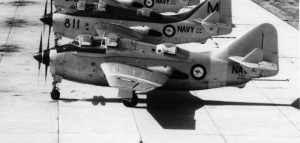Fairey Gannet T.2/T.5
| Type |
Carrier borne anti-submarine training aircraft |
|---|---|
| Manufacturer |
Fairey Aviation Co Ltd, Hayes, Middlesex, UK |
| Number Ordered |
4 |
| First Delivered |
October 1955 |
| Last Delivered |
September 1958 |
| Length |
43 feet |
| Height |
13 feet 8.5 inches |
| Weights | 15,069 |
| Dimensions | Wing span: 54 feet 4 inches |
| Speed | 299 mph |
| Range |
662 miles |
| Crew |
4 |
| Engines |
|
| Performance |
|
| Armament |
Bombs: 2 x torpedoes in bomb bay, 16 x 60 lb rocket projectiles under wings |
| Operated by |
Naval Air Station Nowra |
In 1945 the Fairey Aviation Company began designing a new advanced carrier borne anti-submarine aircraft for the Royal Navy (RN). The prototype first flew in September 1949 and, following successful trials, the RN ordered the Gannet AS-1 as its new anti-submarine aircraft and the aircraft entered RN service in 1954. The Gannet was a rugged aircraft, powered by a 2950 shp Double Mamba 100 engine powering two contra-rotating propellers on a single hub; thus giving it a single-engine profile with two-engine performance. This space-saving feature along with its kerosene-fuelled turbines, tricycle undercarriage and folding wings made the Gannet ideal for service in aircraft carriers. Its large bomb bay, wing-mounted weapons and a retractable radar dome made it a formidable ASW aircraft. The Gannet was crewed by a pilot, observer and electronic equipment operator; each had a separate cockpit with a wide arc of visibility.
With a range of some 660 miles (about 995 km), and a munitions load of up to 2850 lbs, the Gannet AS-1 was well equipped for operating over a large area, in adverse weather conditions for either day or night anti-submarine patrols. It could carry marine markers (smoke flares), directional sonar buoys, parachute flares, and in different combinations 250lb or 500lb bombs, depth charges and/or the Mk 30 acoustic torpedoes. Underwing hard-points could carried 250lb bombs or depth charges. The 16 underwing RP3 air-to-surface rockets (target dependent) used 60lb high explosive or shaped-charge heads, and the 25lb solid steel heads or anti-submarine heads fired at 600 yards could easily penetrate a submarine hull. Despite its bulky ‘ugly duckling’ appearance the Fleet Air Arm pilots considered it pleasant to fly, with responsive controls and it was a stable weapons platform.
As a result the Royal Australian Navy (RAN) also decided to purchase the Fairey Gannet for use on board aircraft carrier HMAS Melbourne. Three Gannet T2 (dual control training aircraft) were obtained in 1957 and one of the Gannet AS-1 later converted to a T5 training aircraft and operated by 724 and 725 Squadrons. The T2/T5 aircraft carried four personnel with instructor, trainee pilot, observer and electronic equipment operator.
After more than a decade of service the Fairey Gannet AS-1 was withdrawn from front line squadron service in July 1967. By then they were redundant and been replaced by the Westland Wessex helicopter with its dipping sonar and the Grumman Tracker S-2E/G with its high-tech electronics and anti-submarine equipment. The four dual control Gannets were used at Nowra for firefighting training in the late 1960s.




